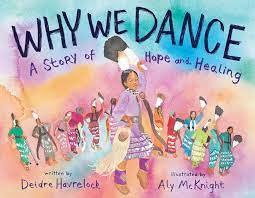Why We Dance: A Story of Hope and Healing

Why We Dance: A Story of Hope and Healing
We girls carry the prayers. We dance side-step, side-step to the RUM-RUM-TUM.
Hearts beating, dresses singing, TINK-TINK-TINK-TINK.
We dance for those who can’t.
Why We Dance: A Story of Hope and Healing is an advanced picture book that takes readers through a day in the life of an indigenous family as they celebrate their culture in a community dance. Beginning in the morning, the story details the young daughters of the family assisting their parents in assembling and repairing the traditional cone dresses the women will wear during the celebration (each cone representing a prayer). The regalia the girls’ auntie will wear is laid out, its colours providing a fabric rainbow the girls marvel at. Next, the girls’ hair is braided and sprayed and makeup is applied playfully to give “a little sparkle”.
Eventually, the family load their outfits and other supplies into their car and arrive at the powwow where other members of the community are already gathered, getting ready for the festivities. The daughters play with the other children while being warned not to ruin their hair in the meantime. The girls briefly worry that they will forget dance steps and mess up the celebration, but their father comforts them, telling them to “just keep dancing” in the wake of any mistakes. Final touches of regalia, as well as tobacco pouches, are added, and the celebration begins. Throughout the dance, different members of the community of all ages celebrate their culture, thanking the Creator “for life and love”, as well as honoring all those who cannot dance with them, with the prose rendering the rhythms and sounds of the dance phonetically.
Deidre Havrelock invites young readers into a celebration of life and love with warm and welcoming prose that educates without overwhelming younger readers. Each aspect of the dance and the accompanying regalia is shown and explained with care, connecting the celebration to core concepts that all readers will be able to understand regardless of background. The framing of the story through the eyes of the young daughters of the family also provides an easy entry point for young readers to understand a cultural celebration that they may not be familiar with from the ground up while keeping the subject matter entertaining. The repeating chorus explaining the meaning of the dance, as well as the repeating sounds, afford a chance for play and interaction when reading to children.
Aly McKnight’s watercolour illustrations echo the warm and inviting tone of Havrelock’s prose, and McKnight depicts each member of the community and each emotional moment with respect and tenderness. The watercolour medium also gives texture to each image, particularly when displaying the regalia and hair of the dancers, giving each cultural detail visceral weight and significance. The wonders of nature, such as the butterflies, the skyline and grass field, are also given their share of life and colour, emphasizing their importance in the celebration.
Following the story are brief Author and Artists’ Notes sharing their inspirations and artistic processes as well as a brief summary of the dance depicted in the story, a traditional dance of the Anishinaabe people.
Tessie Riggs, a librarian living in Toronto, Ontario, never leaves the house without a book.
